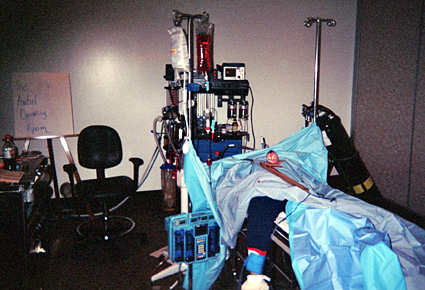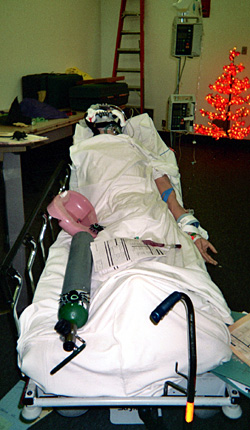Mishap Mansion: A Patient Safety “House of Horrors”
September / October 2007
Mishap Mansion
A Patient Safety “House of Horrors”

![]()
One of the biggest challenges in improving patient safety is engaging staff members to learn and accept new behaviors. As the patient safety coordinator at an acute care facility, I am constantly looking for new ways to catch their attention. It is my experience that education presented in a fun and non-threatening way often has the greatest impact.
In that vein, in October 2006 I decided to create a haunted house of patient safety issues — a “Mishap Mansion” — for the staff at my hospital. The first challenge was to assemble a group of people to help with this endeavor. Staff members from health information management (HIM), respiratory therapy, anesthesia services, education, laboratory, and engineering bravely stepped forward to offer ideas and lend a hand. We scheduled Mishap Mansion on the day prior to Halloween because many staff members take Halloween off to spend time with their children. The hours were from 10:00 am to 2:00 pm and from 9:00 pm to 11:00 pm. At many facilities, night-shift employees are left out of inservice training and workshops due to staffing constraints. That is unfortunate, especially because of the high percentage of new graduates and decreased supervision on that shift. So it was deemed important to have a second shift of Mishap Mansion for the night shift. We also made it a priority to include non-clinical staff.
Our team provided a variety of great ideas and perspectives. Our HIM member is a big Halloween fan, and she provided all sorts of props and devices. Our engineering representative was invaluable, providing horrible broken furniture from the basement. The HIM representative made up face sheets for Herman Munster, Vlad the Impaler, Morticia Adams, Freddy Krueger, and Marvin the Martian. We had trash on the floor, biohazards, tubing misconnections, drug and blood mistakes, a ventilator hooked up improperly, and countless other problems. Our lab representative provided us with many specimen containers and examples of possible mislabeling. The anesthesia services representative contributed an anesthesia machine, cart, and other OR equipment.
 |
|
We strategized on the make-up of the room. We decided to use a conference center at the hospital, which is near the cafeteria, and to allow only facility employees and healthcare professionals to enter. We used fake blood, vomit, and of course, creepy spiders and rats. We agreed not to use props that were overly sinister, but our props were often overwhelmingly “life like.” We obtained CPR dummies from the education department and set up actual charts with face sheets for each station. Our mansion had a Spooky Lobby, Eerie ED, Awful OR, Mysterious Med-Surg, Ominous OB, and Icky ICU. We dimmed the lights and played Halloween music in the background.
Although Mishap Mansion was presented in the “spirit of fun,” we wanted to focus on serious issues. We divided the room into areas to facilitate foot traffic and separated the displays with plastic sheeting to develop a sense of anticipation for the next spooky area. Each area manned by staff. Visitors inspected each station and wrote down all of the errors they could find before moving on to the next.
At the end of the tour, participants handed in their completed quiz sheets and got treats. All participants, including clinical and non-clinical staff, were entered in a raffle to win gift certificates to area restaurants.
During our evening shift, our ED staff sent over some outside paramedics for a tour. They were quite amused with our ED “patient.” Staff members manning the stations were able to provide education about tubing misconnections, mislabeling of specimens, high-risk medications, and cylinder safety. The nonclinical staff members were able to identify items as being incorrect, and they were given information about the “how and why.” Some of our most positive feedback came from participants from nonclinical areas such as finance and HIM.
Many staff members came back for a second visit because they didn’t want to miss any areas. The overall attendance for our first Mishap Mansion was over 150 people. It took several hours to set up the displays, but it was well worth the time.
This year we plan to modify some of our scenarios and to decrease the number of stations to avoid repetition. We will continue to have a spooky lobby and probably three other areas. We expect to have an even larger group come through since so many of our staff members have shared their experiences via word of mouth.
Kristin Gillard is the clinical patient safety coordinator at St. Bernardine Medical Center in San Bernardino, California. Her clinical background includes orthopedics, surgery, and legal nurse counseling. Gillard may be contacted at Kristin.Gillard@chw.edu.
